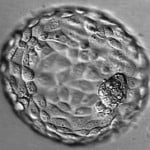We are experiencing a very high volume of calls and messages and ask for your patience. We will answer your portal messages within 48 hours.
We are experiencing a very high volume of calls and messages and ask for your patience. We will answer your portal messages within 48 hours.


Many fertility patients are curious about what exactly happens in the embryology lab, from the time their eggs are retrieved to the time they are transferred. When people have answers to their questions about the details of embryo development, IVF can become a less mysterious process for them.
With that in mind, here is a day-by-day timeline of what happens in the embryology lab in IVF.

This is known as your retrieval day. On day 0, the eggs are retrieved from the follicles that have resulted from your ovarian stimulation. At this time the retrieved eggs are counted and assessed for maturity/quality.
The sperm is also prepped and readied for insemination or ICSI of the retrieved eggs. Approximately 4-6 hours after your retrieval, the eggs will be inseminated or injected with sperm (ICSI). This image shows a mature egg (metaphase II) at the moment of ICSI.

The eggs are evaluated for fertilization, the fusion or combining of the egg and sperm, approximately 16-18 hours after insemination. Normal fertilization is the presence of two pronuclei, one from the egg and one from the sperm.
 If there are too few or too many pronuclei, that embryo is considered abnormally fertilized. All normally fertilized embryos are put into a special media that mimics the tubal fluid found in the human body.
If there are too few or too many pronuclei, that embryo is considered abnormally fertilized. All normally fertilized embryos are put into a special media that mimics the tubal fluid found in the human body.
The gold-toned image (above right) shows a normally fertilized embryo. The black-and-white one (above left) shows an abnormally fertilized embryo.
 The embryos are briefly looked at to assess cell division. Most embryos will have between 2-4 cells on day 2. The image to the right shows a 2-day-old, 4-celled embryo.
The embryos are briefly looked at to assess cell division. Most embryos will have between 2-4 cells on day 2. The image to the right shows a 2-day-old, 4-celled embryo.
If the embryo has not divided by this time, that embryo is considered non-viable.
At this time, embryology will decide if a day 3 or a day 5 transfer will occur. This is typically based on the quality of cell division of the embryos, and the number of embryos available.

Day 3: Embryos at this stage usually have 6-8 cells. If you are having your embryo transfer, assisted zona hatching, making a breach in the shell of the embryo might be performed.
This is also the day embryo biopsy for PGD (pre-implantation genetic diagnosis) may occur. If you are not having your transfer, the embryos are placed into new media that mimics the uterine fluid of the human body.
 Your embryos continue to grow and develop into a compact ball of cells, about 16 in all, known as a morula. If compaction does not start to occur on this day, blastocyst formation rates are decreased. This image shows a compacted day 4 morula.
Your embryos continue to grow and develop into a compact ball of cells, about 16 in all, known as a morula. If compaction does not start to occur on this day, blastocyst formation rates are decreased. This image shows a compacted day 4 morula.
 On day 5, the embryo develops into a blastocyst. At this stage, it is usually possible to grade the inner cell mass (ICM), the fetal component, and the trophectoderm cells (TE), the placental component, of the embryo. Embryo transfers are often done on day 5, as well as cryopreservation of any fully expanded blastocysts. Any remaining viable embryos that are not fully developed are cultured on for possible freezing on day 6.
On day 5, the embryo develops into a blastocyst. At this stage, it is usually possible to grade the inner cell mass (ICM), the fetal component, and the trophectoderm cells (TE), the placental component, of the embryo. Embryo transfers are often done on day 5, as well as cryopreservation of any fully expanded blastocysts. Any remaining viable embryos that are not fully developed are cultured on for possible freezing on day 6.
 Day 6: Embryos on day 6 must be either transferred, if transfer was not done on day 5, or frozen.
Day 6: Embryos on day 6 must be either transferred, if transfer was not done on day 5, or frozen.
Any non-viable embryos are discarded. Day 6 is the last day that an embryo can remain in the lab without being transferred or cryopreserved.

Entire Website © 2003 - 2020
Karande and Associates d/b/a InVia
Fertility Specialists
